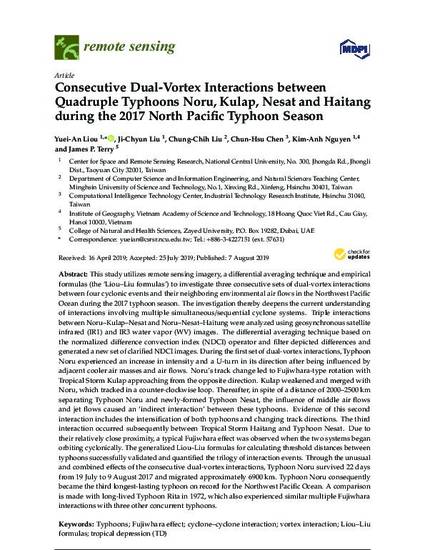
© 2019 by the authors. This study utilizes remote sensing imagery, a differential averaging technique and empirical formulas (the 'Liou-Liu formulas') to investigate three consecutive sets of dual-vortex interactions between four cyclonic events and their neighboring environmental air flows in the Northwest Pacific Ocean during the 2017 typhoon season. The investigation thereby deepens the current understanding of interactions involving multiple simultaneous/sequential cyclone systems. Triple interactions between Noru-Kulap-Nesat and Noru-Nesat-Haitung were analyzed using geosynchronous satellite infrared (IR1) and IR3 water vapor (WV) images. The differential averaging technique based on the normalized difference convection index (NDCI) operator and filter depicted differences and generated a new set of clarified NDCI images. During the first set of dual-vortex interactions, Typhoon Noru experienced an increase in intensity and a U-turn in its direction after being influenced by adjacent cooler air masses and air flows. Noru's track change led to Fujiwhara-type rotation with Tropical Storm Kulap approaching from the opposite direction. Kulap weakened and merged with Noru, which tracked in a counter-clockwise loop. Thereafter, in spite of a distance of 2000-2500 km separating Typhoon Noru and newly-formed Typhoon Nesat, the influence of middle air flows and jet flows caused an 'indirect interaction' between these typhoons. Evidence of this second interaction includes the intensification of both typhoons and changing track directions. The third interaction occurred subsequently between Tropical Storm Haitang and Typhoon Nesat. Due to their relatively close proximity, a typical Fujiwhara effect was observed when the two systems began orbiting cyclonically. The generalized Liou-Liu formulas for calculating threshold distances between typhoons successfully validated and quantified the trilogy of interaction events. Through the unusual and combined effects of the consecutive dual-vortex interactions, Typhoon Noru survived 22 days from 19 July to 9 August 2017 and migrated approximately 6900 km. Typhoon Noru consequently became the third longest-lasting typhoon on record for the Northwest Pacific Ocean. A comparison is made with long-lived Typhoon Rita in 1972, which also experienced similar multiple Fujiwhara interactions with three other concurrent typhoons.
- Cyclone-cyclone interaction,
- Fujiwhara effect,
- Liou-Liu formulas,
- Tropical depression (TD),
- Typhoons,
- Vortex interaction
Available at: http://works.bepress.com/james-terry/14/
